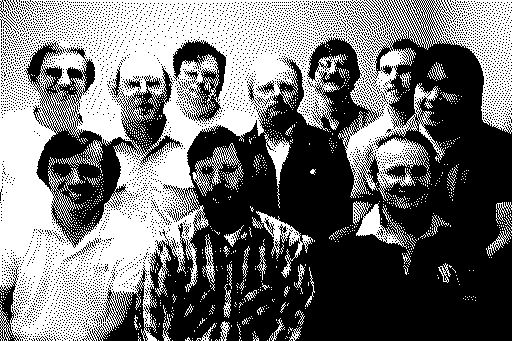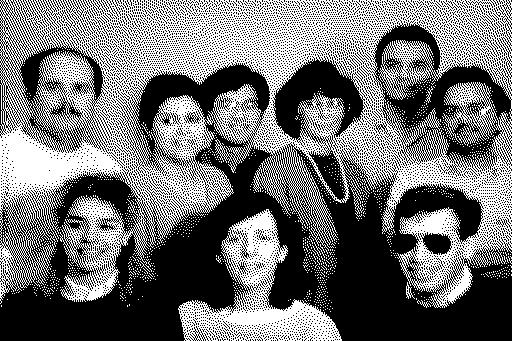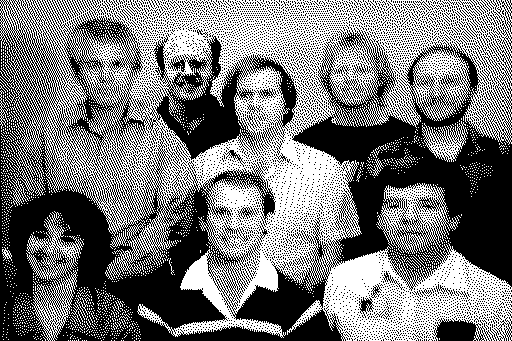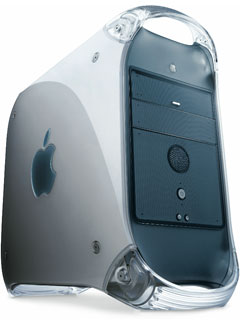Vintage Mac News is a roundup of news related to vintage Macs* and
other older Apple products. For other Mac and Apple news, see Mac News Review. For iBook, PowerBook, and other
portable news, see The 'Book Review.
iPad, iPod, iPhone, and Apple TV news is covered in iOS News Review.
Purchases made through links to Amazon.com and
Apple's iTunes/iBook/App/Mac App Store support Low End Mac.
News & Opinion
History
Reviews
Software
News & Opinion
Hidden Images Discovered in Mac SE ROMs
The geeks at NYC Resistor managed to extract and decompress four
images stored in the ROMs of a Macintosh SE - images that had gone
unnoticed for 25 years. These "Easter Eggs" show the Mac SE development
team. We've reduced them so you can see all four at once:




Link: Ghosts in
the ROM
Why the Sawtooth Is the Greatest Mac Ever Made
PowerPC Liberation says:
"Many people have their favorite Mac and for several different
reasons. A lot of people in the Mac world tend to put aesthetics before
function and expandability by choosing impractical but pretty
computers. The Cube and
any iMac from the G4 model on are perfect examples of this."

Sawtooth Power Mac G4
"...the Power Macs Apple made in the 1996 - 2002 (8600 - Quicksilver) era are the
most reliable computers Apple ever made. Within this elite group of
hardware the Sawtooth
has the greatest track record of them all in both personal experience
and Apple service records."
"I actually switched from computing with 2x MDD (dual 867 and 1.42)
to 2x Sawtooth in 2009. The dual 867 was decently reliable but the dual
1.42 had some real issues with stability on every OS I ever ran on
it."
"When most hear about my switching from the MDD to the Sawtooth they
ask things like 'why would you do that?'. The answer is reliability
combined with the G4 7448 CPU . . . The MDD's fail me on both these
needs because they are not nearly as reliable as other G4's and they
cannot take any of the 7448 upgrades since they are all only compatible
from the Sawtooth through to the Quicksilver.
"The Sawtooth are not only the most reliable Power Mac but also one
of the cheapest to buy of all the AGP equipped models. I see them these
days for 40-80. Cheap enough that I have 5 total and plan to buy
another few for a cluster I plan on building. 8+ systems is the sweet
spot for G4 clusters and I still want a few spares if the day comes
that I need parts."
"MDD's are by far the most unreliable of all the G4 towers. Many
people are understandably enticed by the stock specs since they are the
highest of all the towers. If someone needs to get the best bang for
their buck and good performance without CPU upgrades a dual 1.0 GHz
Quicksilver might be the best choice for the long run.
"The Gigabit Ethernet model has the same 2 GB RAM capacity as the
Sawtooth vs. the 1.5 GB limit in the Digital Audio and Quicksilver.
Over the years though I have noticed the Gigagbit PSU's are not near as
reliable as the Sawtooth are. I would prefer the onboard gigabit vs.
the gigabit PCI card I have to use but the PSU tradeoff made the choice
for me.
"The DA and QS are both very reliable towers but in my experiences
the extra 512 MB RAM the Sawtooth allows is more of an overall system
benefit than the 33 MHz faster bus and AGP 4x vs. 2x. OS X loves RAM as
we all know so the 33% extra of 2 GB vs. 1.5 GB and better PSU is why I
chose the Sawtooth."
"Everyone has their own prerequisites for what makes a perfect
computer but longevity, reliability and expandability are qualities
that virtually anyone can get on board with. The Sawtooth meets all
these needs and then some. They may be 12 years old now but when used
by the right people they can still be extremely capable in the modern
world."
Link removed at the request of PowerPC Liberation.
Video Playback on G3 Macs
PowerPC Liberation says:
"The recent news of the new Mars rover being powered by a 200 MHz G3 is making
some reevaluate their perception of the G3's ability. The early G4
chips are fundamentally just a G3 with an added AltiVec unit. The
final Power Mac G3 and
the first G4 tower even
share the same logic board and CPU socket. In terms of video playback
though the lack of AltiVec is a big hit on performance but there is
still lots you can do with the right codecs and software.
"I started out watching and collecting compressed digital video on a
regular basis in 2002 . . . in August that year when 10.2 was released a big swarm of BSD
and Linux apps started getting ported over thanks to the BSD based
kernel . . . it was this mid-late 2002 era when digital video playback
really took off on the Mac."
"The hardware I had in 2002 when I really got into DivX was a
B&W G3 350 MHz with 256 MB memory and running 10.2 with an early
Mplayer OS X build. It wasn't really till around 2004 that h.264 became
more common but DivX based codec are still common today . . . A G3
cannot really cope with h.264 until you get to at least 700 MHz but
even then it drops frames. DivX, XviD and DVD are your best options for
successful playback.
"For those that really desire to watch YouTube video and only have a
G3 to do it with you will need a 700-800 MHz at minimum and the
tolerance for dropped frames...."
The article includes links to several video playback apps for G3
Macs.
Link removed at the request of PowerPC Liberation.
History
History of the Floppy Disk
Steven Vaughan-Nichols writes:

The floppy disk family: 8", 5.25" and 3.5"
"...IBM had decided as early as 1967 that tape-drives, while fine
for back-ups, simply weren't good enough to load software on
mainframes. So it was that Alan Shugart assigned David L. Noble to lead
the development of 'a reliable and inexpensive system for loading
microcode into the IBM System/370 mainframes using a process called
Initial Control Program Load (ICPL).' From this project came the first
8-inch floppy disk."
"The 8-inch drive began to show up in 1971 . . . the early
single-sided 8-inch floppy could hold the data of up to 3,000 punch
cards, or 80K...."
"Some early model microcomputers, such as the Xerox 820 and Xerox
Alto, used 8-inch drives, but these first generation floppies never
broke through to the larger consumer market. That honor would go to the
next generation of the floppy: the 5.25 inch model.
"By 1972, Shugart had left IBM and founded his own company, Shugart
Associates. In 1975, Wang, which at the time owned the then big-time
dedicated word processor market, approached Shugart about creating a
computer that would fit on top of a desk. To do that, Wang needed a
smaller, cheaper floppy disk.
"...Wang's founder Charles Wang said, 'I want to come out with a
much lower-end word processor. It has to be much lower cost and I can't
afford to pay you $200 for your 8" floppy; I need a $100 floppy.'"
"So, Shugart and company started working on it . . . 'It's real
simple, the reason why it was 5-1/4 . . . 5-1/4 was the smallest
diskette that you could make that would not fit in your pocket. We
didn't want to put it in a pocket because we didn't want it bent,
okay?'"
"Wang wasn't the most important element in the success of the
5.25-inch floppy. George Sollman, another Shugart engineer, took an
early model of the 5.25" drive to a Home Brew Computer Club meeting.
'The following Wednesday or so, Don came to my office and said,
"There's a bum in the lobby,"' Sollman says. '"And, in marketing,
you're in charge of cleaning up the lobby. Would you get the bum out of
the lobby?" So I went out to the lobby and this guy is sitting there
with holes in both knees. He really needed a shower in a bad way but he
had the most dark, intense eyes and he said, "I've got this thing we
can build."'
"The bum's name was Steve Jobs and the 'thing' was the Apple
II."
Link:
The History of the Floppy Disk (thanks
to OSnews)
Software
AuroraFox: Up-to-Date Firefox for PPC Leopard
AuroraFox Development says:
"AuroraFox aims to provide the premier Firefox experience for
Power Macintosh users on Mac OS X 10.5 by combining the advancements of
TenFourFox with Mac OS X Leopard support from Mozilla."
AuroraFox is currently at version 17a2.
System requirements:
Publisher's note: I have to say, I'm using this instead of
TenFourFox on my Leopard machine. I really like it! dk
Link: AuroraFox
SeaMonkey for PPC Project Launched
PowerPC is dying hard.
"hj" of the new SeaMonkey for PPC project says:
"Since Mozilla has stopped supporting PPC on Macs I have picked it
up and provide the only SeaMonkey version runnable on G4/G5 based
Macs....
"For as long as it will be possible, I will maintain a working
version of SeaMonkey for PPC based Macs.
"Since 10.5.x is the last Mac OS X version to support the PPC
processor I'll limit myself to 10.5 builds.
"I will also provide, as time permits, builds for Ubuntu/Lubuntu
12.10 which is PPC friendly as well. Everyone should consider finding a
Unix alternative to MacOS on your PPC machines.
"Spread the word please, make this effort worth my while and get
those PPCs out of the closet and back on line!"
For the uninitiated, SeaMonkey is a suite of Web applications in one
integrated package including a Web browser that shares much of the same
base code as Mozilla.org's Firefox Web browser. SeaMonkey also includes
an advanced email and newsgroup client, an IRC chat client, and a HTML
editor.
Sadly for those of us still running PPC hardware that only supports
up to OS X 10.4 Tiger, there is no Tiger compatible version supported
by the SeaMonkey for PPC project, and it's explicitly stated that there
are no plans for there to be one, but a salute to hj for keeping the
software alive for OS X Leopard PPC users for a while yet.
System requirements:
Link: SeaMonkey PPC
Link: Downloads
DivX 6 Converter/Encode for Mac PowerPC
Mac PowerPC reports:
Intel Macs can run DivX8, and "PowerPC Macs can still install DivX6.
It's good software to have installed because it plays all DivX videos
and MKV formats. You can convert files ending in one of the following
extensions: .mov, .mpg, .mpeg, .mp4, .avi and divx, by just dragging
and dropping!"
Download DivX 6 (Demo) -
Leopard 10.5 and (maybe Tiger 10.4) PowerPC
Link:
DivX 6 Converter/Encode for Mac PowerPC
Stop Spinning Beachballs while Browsing with
Absolute Load Control
PPC Luddite writes:
"I've been noticing lately that more pages in TenFourFox don't
finish loading, or rather they finish except for one pesky process
where the status bar displays 'Transferring from
scorecardresearch.com...' or some BS. This isn't a problem except that
if you open a lot of tabs on the same site, all your tabs will have
spinning progress animations going indefinitely as the pages refuse to
finish. On older computers like PowerPCs, this can take up a large
percentage of your CPU power, and if you're on a laptop, a large
percentage of your battery.
"If you have many tabs open, it can be inconvenient to go to each
one and manually hit the stop button which is where the Firefox add-on
Absolute Load Control comes in. After installing it, you simply
right-click, or control-click, on the stop button and it drops down a
menu with among other options 'Stop All Tabs.' Problem nixed and
fixed."
Link:
Save Electricity with Absolute Load Control
CleanApp for Mac PowerPC
Mac PowerPC reports:
"...talking about cleaning, and organizing let's not forget about a
great application called CleanApp. It's a really good app that keeps
your Mac clean when you uninstall any application because it deinstalls
all the files like logfiles, plists and cache cluttering folders. But
the best feature that I'm most impressed with is the 'Secure and
Archive'. This feature basically tests uninstall and archives all your
data in case you have a second thought...."
Download CleanApp
3.4.12 (Shareware - $14.99) 10.4 (Tiger) / 10.5 (Leopard)
Link: CleanApp
for Mac PowerPC
Open Sonic (the Hedgehog) for Mac PowerPC
Mac PowerPC reports:
"Open Sonic is an open source game based on the Nintendo Sega classic, Sonic
the Hedgehog. With this game you can control 3 characters
simultaneously...."
Download
Open Sonic the Hedgehog (Free) 0.1.4 PowerPC
Link:
Open Sonic (the Hedgehog) for Mac PowerPC
Vintage Mac
Deals
Low End Mac updates the following price trackers regularly:








